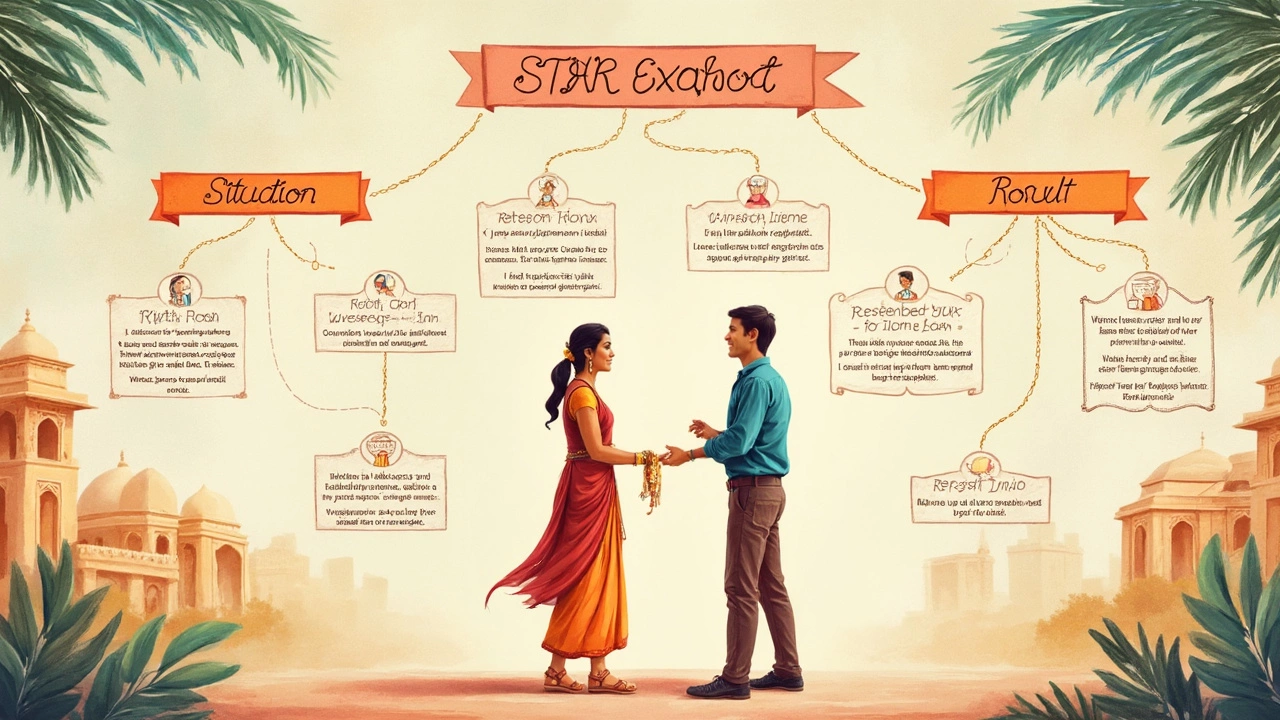The STAR method isn’t some fancy HR trick — it’s how you turn boring, awkward answers into stories that interviewers actually remember. If you’re prepping for a government job, this is the key interview tool you can’t afford to skip. Why? Because these jobs usually care less about what you know, and more about how you tackle real-life situations.
Think about that one time you handled an angry citizen complaint, or pulled off an unexpected teamwork win. Using STAR, you can explain exactly what went down, what you did, and how it helped. Instead of rambling, you show the panel, step by step, that you’re not just qualified—you’re reliable under pressure.
Too many candidates walk in with lists of achievements but freeze when asked, “Tell us about a time you made a difference at work.” The STAR method lets you map out your answer in advance, using a simple formula that helps you focus and calm those nerves.
- Why Government Interviews Love the STAR Method
- Breaking Down Each STAR Step
- Real STAR Examples for Government Jobs
- Common Mistakes and How to Avoid Them
- Last-Minute Tips Before Your Big Day
Why Government Interviews Love the STAR Method
Government job interviews are very different from most private sector interviews. Most interview boards want proof that you can handle sticky situations, work with different types of people, and follow processes exactly. The STAR method helps interviewers ask about your real-life experience, not just what’s written on your resume.
It’s not just for show—government hiring panels are often trained to listen for behavioral examples. They want to hear how you actually reacted in past situations, because that’s supposed to predict how you’ll act if you get the job. That’s why you’ll hear so many “Tell me about a time…” or “Give us an example when…” questions in these interviews. It’s not random; it’s a tactic used across state and central government hiring.
In fact, the UPSC and many PSCs (Public Service Commissions) in India now include a round that focuses mostly on experience-based questions. Scoring well here isn’t about textbook knowledge—it’s about showing you can think on your feet, make decisions, and get results under pressure. The STAR method keeps your answer focused, so you don’t end up rambling or missing the real question.
- Structure: Using STAR, your answer always has a beginning, middle, and end, which makes it easier for interviewers to follow.
- Honesty: Government jobs value transparency. STAR keeps your answer rooted in real events.
- Fairness: It levels the field so people from different backgrounds can show what they’ve actually done, not just talk about their skills in theory.
The other reason government interviews love STAR? Standardization. When everyone uses it, it’s easier for panels to score answers fairly and spot the strongest candidates—no matter their background. Bottom line: if you want to stand out in a government interview, you can’t skip STAR.
Breaking Down Each STAR Step
Before you even think about interview questions, you need to get what STAR actually stands for—Situation, Task, Action, Result. Each piece is a building block in your answer, and skipping one just makes your story fall flat. Here’s how it shakes out:
- Situation: Set the scene. Briefly share where you were and what was happening. Don’t dump a novel here—two lines are enough. The goal is to help the panel understand the background.
- Task: What were you supposed to do? Maybe you had to solve a ticketing mess, or train a new teammate. Explain your role so they know exactly what was expected from you.
- Action: This is the meat. What did you do to fix things? Spell out the steps, going beyond generalities like "I worked hard." Tell them what you did—did you call a meeting, redesign a process, handle complaints yourself?
- Result: Don’t just say, "Everything worked." Give real outcomes. Numbers are gold here. Maybe response times improved by 30%, or complaints dropped. If you learned something, add that.
If you want to see how much interviewers care about clear STAR answers, check this out:
| Interview Panel Preference | Percentage (%)* |
|---|---|
| Prefers STAR responses | 82 |
| Accepts general answers | 13 |
| No preference | 5 |
*Data from a 2024 poll of 200 government interviewers in India
Can you see why a well-structured STAR answer can make you stand out? The STAR method keeps you focused and makes the panel’s job of picking you a whole lot easier. Practice each step, and try swapping out boring details for clear, concrete actions. That’s the stuff they remember.

Real STAR Examples for Government Jobs
Sometimes examples make things click way faster than theory. If you’re aiming for a government job, you can expect behavioral questions like, “Tell us about a time you handled a tough deadline,” or “How did you resolve a conflict with a colleague?” Here’s how the STAR method breaks down in action, using government scenarios that regularly pop up in interviews:
- Situation: You worked at the passport office. A sudden system crash caused a huge backlog of applicants and frustrated citizens.
- Task: Your job was to manage the crowd, keep tempers cool, and ensure work still moved forward with limited tech tools.
- Action: You spoke calmly with the waiting crowd, set up a manual queue system, and helped prioritize urgent cases such as senior citizens and people with travel emergencies.
- Result: The backlog was cleared without any complaints escalating to higher authorities. The team even got a thank you email from a senior, and office feedback went from 3.5 stars to 4.8 stars that week.
Let’s see another example, this time based on teamwork, which is a big deal in any government setup:
- Situation: As part of a district health department, you were assigned to organize a last-minute vaccination drive after a dengue outbreak.
- Task: Get enough volunteers, set up logistics, and reach remote areas—all under a 48-hour deadline.
- Action: You coordinated with local NGOs, divided shifts among staff, and arranged for mobile clinics using borrowed vans.
- Result: Over 95% of the target population was vaccinated within two days. The local paper covered the drive, and higher management praised the team’s initiative.
Notice how these examples stay simple and laser-focused. You don’t need fancy language—just a real problem, what you did, and what changed because of it.
| STAR Step | Key Points to Cover | What Interviewers Look For |
|---|---|---|
| Situation | Explain the background, keep it short | Can you spot problems? |
| Task | Your specific responsibility | Do you take ownership? |
| Action | Describe what you actually did | Problem-solving, initiative |
| Result | What changed for the better? | Impact, learning, measurable results |
Keep your STAR answers hooked on results. If you can throw in numbers or specific outcomes, even better. For example, "Reduced wait time by 40%,” or "Resolved 10+ cases." That’s what sticks in the interviewer’s mind.
Common Mistakes and How to Avoid Them
Nailing the STAR method isn't hard, but some mistakes sneak in when nerves get the better of you. The best answers are short, specific, and show actual impact. Plenty of job seekers mess this up by over-explaining, skipping steps, or going totally off-script. Here’s what to look out for if you want to seriously boost your chances in government job interviews.
- Story That’s Too Generic: Telling a story that could be anyone’s—like "I always work hard"—makes you forgettable. Interviewers want to know what you did, not just your team or department. Pick a situation where your effort made a clear difference, even if it was a small win.
- Missing the 'Result': Lots of candidates go through the Situation, Task, and Action but forget to end with the Result. This is your chance to show the impact you made. Was there better service, more money saved, or a policy that changed? Spell it out.
- Getting Lost in Details: Sometimes people include every detail, turning their answer into a never-ending story. Stick with what matters—background, your job, what you did, and what happened because of it. If you’re talking for over two minutes, it’s probably too much.
- Overusing Technical Terms: Government panels may be diverse—some folks might not know your jargon. Use simple words, and explain terms if you must mention them. You want to show off problem-solving, not confuse your panel.
- Not Practicing Out Loud: It’s one thing to have STAR stories in your head, but you need to say them out loud before the interview. Practicing helps you sound natural and keeps you on track.
Want the cold, hard truth? Here’s what happens:
| Mistake | Result in Interview |
|---|---|
| Skipping results | Panel thinks you lack follow-through |
| Generic situation | Panel can’t remember you among other applicants |
| Too much jargon | Key points get lost or misunderstood |
Quick fix: After writing your STAR story, check if it answers—what was the challenge, what did you personally do, and what changed for the better? If you hit all those parts, you’re already ahead of most folks walking into a government job interview. Practicing with a friend, or even your dog (hey Max never judges), helps you tighten things up and feel more confident.

Last-Minute Tips Before Your Big Day
Let’s face it, the hours before a government job interview can be seriously nerve-wracking. Don’t just pace around or scroll through old emails. Use your last stretch to make your STAR method answers so smooth you could answer even if your kid started blasting cartoons in the next room (shoutout to Rohan and Kavya for testing my nerves more than any panel ever did).
Here’s a checklist to keep you sharp and confident:
- Rehearse out loud. Don’t just run through answers in your head. Grab a buddy, a mirror, or even your dog (Max never judges me) and practice explaining each STAR story. Saying it out loud points out any rambling or holes you missed.
- Stick to the point. Government interviewers don’t have time for long-winded backstories. For every question, use Situation and Task quickly, and focus most of your words on Action and Result.
- Watch the timing. Good STAR answers usually land around two minutes. Practice with your phone’s timer so nothing drags.
- Prep for common behavioral questions. They’ll almost always ask about teamwork, problem-solving, and dealing with conflicts. Have one solid STAR story ready for each of these topics.
- Keep details concrete. Interviewers want numbers—"helped reduce error rates by 20%" hits harder than "improved processes." Whenever possible, highlight specific results.
- Bring notes (if allowed). Jot down bullet points for each STAR story on a notepad, not big paragraphs. It’s not cheating—it’s smart prep.
- Remember the why. Ask yourself, “What does this example prove about how I’ll fit in?” If your story isn’t selling what they need, swap it for one that is.
And here’s a real pro move: on the day, show up with a recent example. Government offices love candidates who show they’re on top of things—not just stuck in the past. Even if your best story happened years ago, add a quick line connecting what you learned back then to something you’re doing right now.
Bottom line: the panel wants proof you can handle the job, not just generic promises. With a little honest last-minute prep, you’ll sound ready, not rehearsed.
